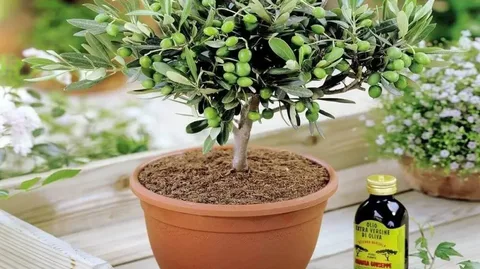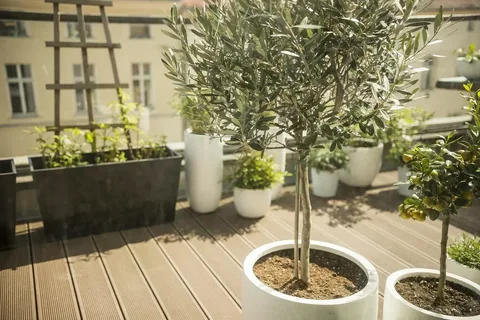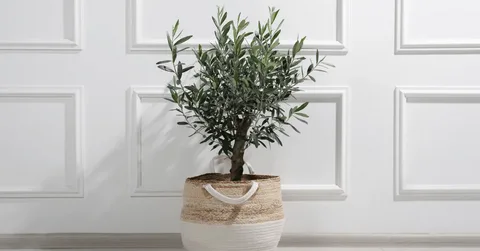Table of Contents
- What is an Indoor Olive Tree?
- Why Choose an Indoor Olive Tree?
- How to Care for an Indoor Olive Tree
- Light Requirements
- Watering Needs
- Ideal Temperature and Humidity
- Soil and Fertilisation
- Pruning and Maintenance
- Common Problems with Indoor Olive Trees
- Best Olive Tree Varieties for Indoor Growing
- FAQs About Indoor Olive Trees
- Conclusion
What is an Indoor Olive Tree?
The indoor olive tree, moreover called Olea europaea, is a smaller model of the Mediterranean olive tree that could thrive in pots or bins in your own home. These timber are recognized for his or her silver-green leaves, twisted trunks, and tiny, however scrumptious olives. While olive timber is usually placed outdoors in warm, sunny climates, growing one indoors has grown to become a famous choice for folks that need to feature a hint of nature to their dwelling region.
In high-quality, olive wood is gradual-growing, in order that they don’t want as a tremendous deal of location or safety as precise indoor wood. This makes them super for condo dwellers or all people looking to increase a tree interior with minimal fuss.
Why Choose an Indoor Olive Tree?

You are probably thinking, “Why do I want to extend an olive tree indoors?” Good question. Here’s why an indoor olive tree is a splendid choice:
- Aesthetic Appeal: Olive timber is visually put with their silvery-grey leaves and twisted trunks. They have to make a lovable focal trouble in any room, whether or not or now not or now not or now not you locate it to your dwelling room, kitchen, or perhaps via the manner of a window.
- Space-Friendly: Unlike outdoor olive timber that could boom as a good buy as 30 ft tall, indoor olive timber stays an awful lot smaller. They can and no longer the usage of a hassle expand in pots, making them extremely good for homes or smaller homes.
- Low Maintenance: Olive timber is hardy and would not require a normal hobby. With the right conditions, you may revel in a thriving tree with minimal attempt.
- Olives at Home: If you’re into domestic gardening and experience growing your personal food, an indoor olive tree also can furthermore want to yield fruit (even though it takes staying strength). You’ll be capable of harvesting sparkling olives right out of your dwelling room.
- Air Purification: Like many indoor plants, olive wood facilitates purifying the air via removing pollution and liberating oxygen. They’re a natural way to enhance indoor air wonderfully.
How to Care for an Indoor Olive Tree
Olive timber is pretty resilient, but they do need the right care to thrive within the interior. Here’s a step-by-step manual on how to attend to your indoor olive tree.
Light Requirements
Olive trees love daytime. In reality, they want a number of it to boom well. If you need your indoor olive tree to flourish, you need to locate it somewhere that gets loads of direct daylight hours.
- Ideal Lighting: Olive timber desires at least 6 hours of direct daylight hours every day. The brilliant places for them are south-dealing with home domestic windows, which get the maximum daytime inside the route of the day.
- Not Enough Light?: If your private home doesn’t get enough natural moderation, you can supplement it with a growth moderation. LED or fluorescent light fixtures can help your tree get the sunlight hours it craves, even in low-light environments.
Watering Needs
Overwatering is one of the most common errors humans make with indoor olive wood. These woods pick out their soil to dry out amongst waterings.
- Watering Frequency: Water your olive tree simplest at the same time because the pinnacle inch of soil feels dry to the touch. Ordinarily, this suggests watering as expedient as every 1 fourteen days, but it is predicated upon on the temperature and dampness of your home.
- Watering Strategy: When you water, guarantee to water profoundly until it begins to expand out of the pot’s waste openings.
- This guarantees the water reaches the roots. Avoid letting the tree take a seat down in extra water, as it could motivate root rot.
Ideal Temperature and Humidity
Olive timber thrive in warm, dry conditions, however they also can tolerate a few temperatures if given the proper care.
- Temperature: Indoor olive timber selections out temperatures among 60°F and seventy five°F (15°C and 24°C). They can cope with a bit cooler or warmer, however intense changes in temperature can motivate strain.
- Humidity: Olive timber is tailored to dry conditions, definitely simply so they don’t want a wet surroundings. Keep your tree in an opportunity dry room, and keep away from placing it near humidifiers or air conditioners.
Soil and Fertilisation
Olive timber desires well-draining soil, so it’s vital to pick out the right shape of potting mixture.
- Soil: A cactus or succulent aggregate works high-quality for olive wooden because it’s designed for instant drainage. You also can combine your very very non-public usage of fifty% potting soil and 50% sand or perlite.
- Fertilising: Fertilise your olive tree as quick as a month within the route of the growing season (spring and summer season) with a balanced, liquid fertiliser. During the fall and winter, at the identical time because the tree goes into dormancy, you may prevent fertilising.
Pruning and Maintenance
To maintain your indoor olive tree wholesome and search for its exceptional, regular pruning is essential.
- Pruning Tips: Prune your tree to remove dead or broken branches. You also can trim it to hold its shape and save you from growing too tall to your place.
- Repotting: As your tree grows, it may want to be repotted each 2-3 years. Choose a barely big pot to provide the roots room to increase. Be immoderate, tremendous to apply clean potting soil on the same time as repotting.
Common Problems with Indoor Olive Trees
While indoor olive bushes are pretty smooth to take care of, they will even face a few common troubles. This is what to view out for:
Yellowing Leaves: This can be an illustration of overwatering or horrendous seepage. Check the dirt dampness and make sure your tree isn’t sitting in water.
Leaf Drop: In the event that your tree begins off evolving off evolving losing its leaves, it thoroughly may be constrained from an incredible substitute in temperature, absence of light hours, or conflicting watering.
Bugs: Olive wood can occasionally draw bothers like aphids, mealybugs, or worm vermin. On the off chance that you are cognizant of little bugs or webbing for your tree, manage it with insecticidal cleaning, purifying cleaner or a blend of water and dish purging cleaner.
Unfortunate Development: In the event that your olive tree isn’t always constantly growing pleasantly, it may very well be due to lacking mild or incorrect watering. Take a stab at changing the area to get extra sunshine hours and make certain you are done overwatering.
Best Olive Tree Varieties for Indoor Growing
Not all olive wood is nice for indoor growing. Here are some types which might be specifically nicely-proper for indoor areas:
- Arbequina: Known for its small period and capacity to conform to indoor environments. It’s one of the most well-known sorts for domestic growers.
- Pendolino: Another compact variety that produces small, notable olives. It’s first rate for smaller indoor areas.
- Leccino: This variety is hardy and does properly indoors, producing tasty olives on your private olive oil or ingesting.
FAQs About Indoor Olive Trees

Q: Can I enlarge an olive tree indoors without it producing fruit?
A: Yes, you may! While a few indoor olive trees can produce fruit, it regularly is based genuinely upon the range, the amount of daylight, and the tree’s age. Even if it doesn’t undergo fruit, your tree will however be an lovable and specific addition to your property.
Q: How fast do indoor olive wood increase?
A: Olive timber are gradual growers, especially interior. They commonly grow between 6-12 inches consistent with one year, counting on the situations.
Q: Can I grow an indoor olive tree from seed?
A: While it’s possible to enlarge an olive tree from seed, it’s a whole lot faster and masses are less complicated, first of all an extra younger tree from a nursery. Growing from seed can take numerous years before the tree is huge enough to provide fruit.
Q: Do I want to pollinate my indoor olive tree?
A: Yes, in case you need your tree to offer fruit, it’ll want to be pollinated. Some indoor kinds, just like the Arbequina, can self-pollinate, but having wood will develop your opportunities of fruiting.
Conclusion
Growing an indoor olive tree is a worthwhile experience, whether or not you’re seeking out a lovely indoor plant or hoping to collect your non-public olives. With the proper care, at the aspect of proper daylight hours, watering, and protection, your indoor olive tree can thrive for many years. These woods are low-safety, aesthetically ideal, and can even purify the air in your own home.
Remember, staying energy is top priority! Olive timber increases slowly, but with a chunk of affection and interest, they’ll be able to make a stunning and practical addition to your home. So, whether or not you are a professional gardener or genuinely starting out, an indoor olive tree might be the right plant for you.
